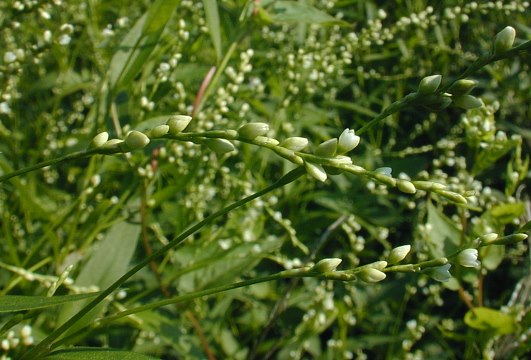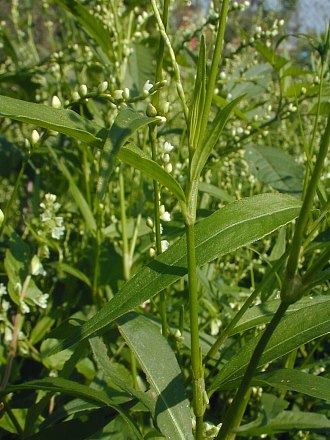Description: This plant is an annual or short-lived perennial that is 1-2½' tall, branching occasionally and rather erect in habit. The round stems are hairless and somewhat broader where the ocreae occur. The alternate leaves are up to 6" long and ¾" across. They are lanceolate-ovate or narrowly ovate, tapering to short petioles. These leaves are usually hairless, except for a few hairs along the lower midrib in some cases, and they have smooth margins. At the base of each leaf, is a sheath (ocrea) that wraps around the stem. This sheath is membranous and hairless, except for a few long bristles along its upper edge. With age, it falls away from the stem.

The upper stems
terminate in more or less erect spike-like racemes about 2-6" in
length. Each raceme has small flowers that are sparsely distributed
along its length. Each flower is about 1/8" (3 mm.) long, white or
greenish
white, and its outer surface (consisting of sepals) has glandular dots
that are either pale- or dark-colored (if pale-colored, a hand lens may
be necessary in order to see them). The 5 sepals of the flower are more
or less tightly folded against each other, while the short style is
divided at its base into 2 or 3 segments. The blooming period occurs
from mid-summer to early fall, and lasts about 1-2 months. There is no
noticeable floral scent. Each flower is replaced by an achene that is
shiny, dark brown to black, three-angled, and rather oblong. This plant
often forms colonies of varying size in wet areas.
Cultivation:
The preference is full or partial sun, moist to wet conditions, in
mucky soil that is high in organic matter. This plant tolerates shallow
standing water.

Range & Habitat:
Dotted Smartweed (Persicaria punctata) is a common plant that occurs in almost every county
of
Illinois (see Distribution
Map), where it is native. Habitats include moist openings in
floodplain forests,
swamps, seeps, borders of ponds and small streams, and drainage
ditches. This plant is often found along the edge of water that is
stagnant or slow-moving, and it appears to favor degraded wetlands.
Faunal Associations:
The nectar of the flowers attracts short-tongued Halictid bees, various
kinds of wasps, Syrphid flies and other kinds of flies, and
occasionally beetles, including ladybird beetles. The Halictid bees
often
collect pollen as well. Larvae of the butterflies, Bronze Copper
(Lycaena hyllus) and Purple Copper (Lycaena helloides), feed on the
foliage of Dotted Smartweed (Persicaria punctata). Other insects that
feed destructively on the foliage and other parts of this plant and
other smartweeds (Persicaria spp.) include larvae of the Black
Wedge-spot (Homophoberia apicosa) and other moths, larvae of sawflies
(Ametastegia spp.), flea beetles (Disonycha spp.), weevils (Tyloderma
spp.), plant bugs, stink bugs, aphids, and grasshoppers (Paroxyna
spp.). See the Insect Table for a more complete list of these species. The nutritious seeds of wetland smartweeds are
popular with many species of ducks, rails, and some
songbirds (see Bird
Table
for a list of species); these birds may help to spread
the seeds to new areas. White-tailed Deer and Muskrats feed on these
plants to a minor extent, as do the Snapping Turtle, Painted Turtle,
Slider, and Eastern Box Turtle (Myers et al., 2004; Hamerstrom &
Blake, 1939; Ernst et al., 1994).
Photographic Location:
A roadside ditch outside of Urbana, Illinois.
Comments:
This is one of the more common smartweeds in wetland areas. It also
occurs in flood-prone areas of woodlands. Dotted Smartweed (Persicaria punctata) is
average-sized and not particularly showy, but the seeds are valuable to
wildlife in wetlands. To identify a smartweed species correctly, it is
necessary to examine the racemes and ochreae (the leaf-sheaths that
wrap around the stem). Dotted Smartweed produces erect racemes with
sparsely distributed flowers, whereas some other Smartweed species
produce racemes that droop (e.g., Persicaria lapthifolium),
or that are densely packed with flowers (e.g., Persicaria
pennsylvanica).
The ochreae of Water Smartweed are hairless,
except for a few long bristles at the top. Other smartweed species may
have ochreae that are hairy across the surface, and they often have
very short or no bristles at the top. Dotted Smartweed also differs
from many other smartweeds by the glandular circular depressions on the
sepals of its flowers, which may require a 10x hand lens to see.